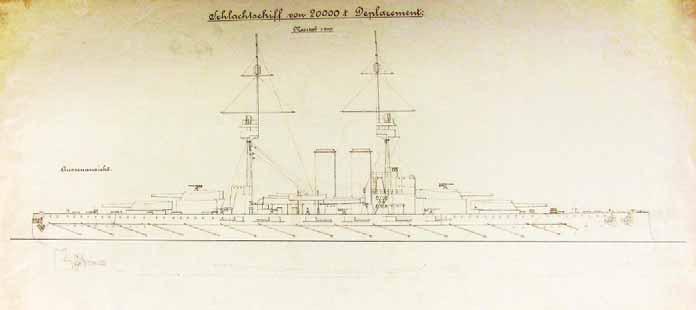battleship with ammunition was 60.6 million Kronen. The STT deposited 4.2 million Kronen (10 percent) at the Creditanstalt in accordance with the contract.200 In January 1910, the Navy signed the contract with the Škoda on the armament.201 On 9 November 1909, the Navy signed the contract with the Witkowitz Ironworks on the armor of the first two dreadnoughts.202 The preparatory works of starting the lofting process in the mold loft on the two battleships were started in the spring of 1910. The cover-names of the two units were Objekt 427 and Objekt 428. Cover-names were needed because officially the Navy did not order these ships. It posed a problem that even in April 1910 some detailed plans were missing, so the subcontractors could not start to manufacture these parts in time.203 On 24 July, the keel of the first unit was laid down. Due to the need for secrecy the usual ceremony was cancelled. Two months later, on 24 September the keel of the second unit was also laid down. Work on the first unit progressed well despite the constant minor modifications of the plans, but the delays of some subcontractors, Witkowitz among them, foreshadowed the exceeding of the time limit. Škoda also informed the Navy that the delivery of the 30.5
guns of the first unit would be delayed by a few months.204 After the delegations had voted in favor of the extraordinary credit the Navy could officially sign the contracts on all the four battleships. The Navy signed the contract with the Danubius on 20 April 1911 on the Schlachtschiff VII. Four days later, on 24 April the Navy signed the official contract with the STT on the Schlachtschiff IV, V and VI. The time limits of the delivery of the STT ships were 1 July 1912, 1 January 1913 and 1 January 1914.205 As the launch date of the first unit approached, the process of naming the ships was started. In the first time of the history of the Navy the proposals were presented to the Military Chancellery of the Heir of the Throne instead of to the Military Chancellery of the Emperor, but the Emperor retained his right to approve the proposals. On 8 March 1911, the Navy presented its proposal to the Military Chancellery of the Heir of the Throne which contained the following names: IV Tegetthoff, V Don Juan, VI Prinz Eugen and VII Hunyadi. The Navy added that the rumors in the press that the name of the first unit would be Franz Joseph were baseless. Franz Ferdinand answered that he approved the name Tegetthoff for the first unit, and
31 The launch of the Tegetthoff on 21 March 1912
— 72 —






























